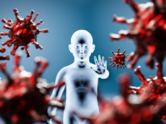- Nashik Times
- Aurangabad Times
- Badlapur Times
You can change your city from here.
We serve personalized stories based on the selected city
Coronavirus
Coronaviruses are a broad family of viruses and are named so because of the crown-like spikes on their surface. Human coronaviruses were first identified in the mid-1960s. It is important to understand that there are hundreds of coronaviruses, most of which circulate among animals including pigs, camels, bats and cats. While coronaviruses are said to be zoonotic in nature i.e. they jump from animals to humans, they sometimes evolve and start spreading from person to person as well.
The novel coronavirus (SARS-CoV-2) is a new strain of coronavirus that has not been previously identified in humans. It first originated in a seafood and poultry market in Wuhan, China. Some of the most common symptoms of coronavirus disease (COVID-19) include dry cough, shortness of breath and fever. These symptoms may appear anywhere between 2 to 14 days after getting infected.
It is currently estimated that a person infected with COVID-19 may infect, on average, between two to three people.
Videos
 06:04
06:04Compulsory tests for moms-to-be
 03:43
03:43Sanjay Leela Bhansali's Heeramandi: Top 5 breathtaking outfi...
 04:09
04:09Bhagavad Gita, Chapter 3, Verse 2: When war and wisdom colli...
 03:56
03:56Bhagavad Gita: Arjuna's doubt! Why fight when knowledge is s...
 06:01
06:01How strict parenting can impact children negatively
 05:55
05:55Mental health- Identifying warning signs to prevent suicidal...
 04:56
04:56How hormones impact ovarian cancer growth
Coronaviruses are a large group of viruses that cause diseases in animals as well as humans. These viruses have crown-like spikes on their surfaces, hence giving them the name “coronavirus''. Corona means “crown" or "halo" in the Latin language. This virus typically leads to an upper tract respiratory infection in humans and can cause illness ranging from the common cold to diseases such as MERS (Middle East Respiratory Syndrome) and SARS (Severe Acute Respiratory Syndrome).
A new virus from the coronavirus family was discovered in December 2019 in the Wuhan City, Hubei Province of China. The novel virus was named 2019-nCoV initially and was identified as belonging to the coronavirus family, which includes SARS and the common cold. The virus which is causing the disease has been officially named SARS-CoV-2 by the International Committee on Taxonomy of Viruses (ICTV).
The disease can spread from person to person through small droplets from the nose or mouth which are ejected when a person with COVID-19 coughs, exhales, sings, talks etc. So, you can get infected if you are in close proximity (less than 1 metre) to a person who has COVID-19 and inhale the droplets. Since these respiratory droplets also land on objects and surfaces, if you touch these surfaces and then touch your face (eyes, ears, mouth and nose) you are likely to get infected.
According to the World Health Organization, some ...
About Coronavirus:
Coronaviruses are a large group of viruses that cause diseases in animals as well as humans. These viruses have crown-like spikes on their surfaces, hence giving them the name “coronavirus''. Corona means “crown" or "halo" in the Latin language. This virus typically leads to an upper tract respiratory infection in humans and can cause illness ranging from the common cold to diseases such as MERS (Middle East Respiratory Syndrome) and SARS (Severe Acute Respiratory Syndrome).
A new virus from the coronavirus family was discovered in December 2019 in the Wuhan City, Hubei Province of China. The novel virus was named 2019-nCoV initially and was identified as belonging to the coronavirus family, which includes SARS and the common cold. The virus which is causing the disease has been officially named SARS-CoV-2 by the International Committee on Taxonomy of Viruses (ICTV).
The disease can spread from person to person through small droplets from the nose or mouth which are ejected when a person with COVID-19 coughs, exhales, sings, talks etc. So, you can get infected if you are in close proximity (less than 1 metre) to a person who has COVID-19 and inhale the droplets. Since these respiratory droplets also land on objects and surfaces, if you touch these surfaces and then touch your face (eyes, ears, mouth and nose) you are likely to get infected.
According to the World Health Organization, some of the most common symptoms of COVID-19 are fever, tiredness, and dry cough. Some of the other common symptoms include difficulty in breathing, muscle pain and sore throat.
COVID-19 has already caused more than 6,500 fatalities worldwide and infected around 169, 287 people globally, according to an estimate from Johns Hopkins University, which is tracking cases reported by the World Health Organization and additional sources.

































































































































































